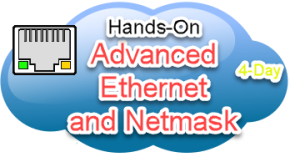CellStream, Inc. – Telecom Consulting and Training! | 4-Day Instructor Led Hands On Lab Class |
Course Description:
This is an advanced L2 Ethernet and Netmask course that leverages Wireshark and packet capture to not only visualize but to learn the advanced Ethernet and Netmask networking topics.
This is an instructor led training (ILT) course that is usually held at a customer location or online with a live instructor.
The course is a combination of knowledge training, systems analysis, with hands-on exercises using Wireshark, and packet cpatures/analysis, designed by CellStream consultants, to bring the technician/engineer, who requires a deeper understanding of Ethernet, Netmask and Storage Area Networking, focusing on iSCSI, RDMA, NVMe, and TCP/IP Addressing. A combination of knowledge training, hands-on exercises, and hands-on experience through execution of Command Line interface to Cisco routing/switching labs reveals the Advanced Ethernet functions in a swift, detailed, and understandable way.
Course Objectives:
The objectives of the course are to:
- Develop a “hands-on” skill set targeted at Ethernet, Netmask, and Storage protocols
- Understand the behavior and operation of these protocols
- Learn how to use critical networking tools and methods
- Improve job performance by having a more complete and robust understanding of the subject matter
- Improve customer/coworker satisfaction by sharing the knowledge and skills to work with and troubleshoot the network
- Deepen networking knowledge and understanding
These objectives are met by covering the necessary technical bases in a straightforward manner, by keeping the content in context of the objectives – connecting the dots. Utilizing a short, subject specific architecture with exercises to drive home key points and Hands-On experience that reveal these points builds skills and knowledge based on Bloom’s Taxonomy. Presentation methodology is industry current and up to date using a technology specialist.
Audience:
The target audience for this course is anyone in the telecommunications and storage area networking field that requires a solid and complete understanding of the fundamental operations of Ethernet networking, especially new hires, and desires hands-on skills that can be applied to their job function. Ideal candidates are:
- Technicians, Network Engineers, Storage Area Networking Engineers, and Supervisors
- Support Technicians/Engineers
- Operations individuals that will provide Ethernet and Netmask configuration and support services
- Development Engineers that must know Ethernet and Netmask networking in order to provide hardware and software solutions
- Network Design Engineers that need to understand Ethernet/Netmask based services and applications
- Network Management individuals that are providing element and network management tools
- Network Administrators and IT professionals
- Technical sales individuals that must be able to correlate features with functionality
- Technical marketing individuals that want more than just a basic understanding of Ethernet and Netmask
- Certification Track individuals that need to expand their knowledge and studies
Course Prerequisites:
All students must attend with a lap-top computer in order to interface to the Online School (web browser) and Wireshark installed on their local machine. If the course is held at a classroom where computers are available, the Lap-top computer will not be required.
Course Materials:
Students will be provided with a Course Student Guide. Students will utilize their own laptops/computers to perform packet and protocol analysis both observing and driving home the knowledge gained.
Course Outline:
- Section 1: Establishing The Groundwork
- Overview and Introductions
- Ethernet Protocol Fundamentals Review
- Important Network and Protocol Performance Drivers
- Section 2: Wireshark Tool Setup and Customization
- Customizing Wireshark and Profile use
- LAB: Creating and Installing Custom Profiles for Wireshark
- Sample Capture File testing
- Section 3: TCP/IP
- Transmission Control Protocol
- MTU vs MSS
- TCP Sockets
- TCP Segmentation
- TCP Sequence and Acknowledgement
- 3-way Handshake
- LAB: TCP 3-Way Handshake Trace Analysis
- Flow Control, Sliding Windows
- TCP Windows
- Congestion Control
- Selective Acknowledgements (SACK)
- Window Scaling
- Delayed Ack, Nagle Algorithm
- TCP Conversation Completeness
- TCP Timers
- LAB: TCP Congestion and Flow Control
- TCP Troubleshooting Workflow
- LAB: TCP Troubleshooting Example Traces/Workthroughs
- Section 4: iSCSI
- SCSI and iSCSI Defined
- Protocol Stack/Illustration/Components
- LAB: iSCSI Profile and Trace Analysis Lab Experiment
- Section 5: RDMA
- Interconnection Model
- InfiniBand and IP over InfiniBand, and Ethernet over InfiniBand
- RDMA Defined
- RDMA Procedures and Methods
- RDMA Similarities/Differences to TCP
- Options for RDMA over Layer 2
- iWARP – Internet Wide Area RDMA Protocol
- RoCE – RDMA over Converged Ethernet
- Protocol Stack/Illustration/Components
- LAB: InfiniBand/RDMA Profile and Trace Dissection Lab Experiment
- Section 6: NVMe
- NVMe Defined
- NVMe Command Processing
- NVMe-oF – NVMe over Fabrics, Options
- NVMe over TCP
- Protocol Stack/Illustration/Components
- Performance Considerations
- LAB: NVMe Profile and Trace Analysis Lab Experiment
- Section 7: Netmask
- IPv4 Addressing
- LAB: IPv4 Addressing Exercise
- IPv4 Subnet Addressing
- Relationship between IP Subnets and VLANs
- LAB: IPv4 Subnet Addressing Tool and Exercises
- IPv6 Addressing
- IPv6 Subnet Addressing
- IPv6 SLAAC – Stateless Address Auto Configuration
- LAB: IPv6 Neighbor Discovery Demonstration and Wireshark Trace Analysis
- ICMPv6: Neighbor and Router Solicitation
- IPv6 Autoconfiguration Demonstration and Wireshark Trace Analysis
- Primary Differences Between IPv4 and IPv6
- LAB: Optional: Dual Stack Network Example/Demonstration
- Section 8: Gateways/Routers
- Gateway/Router Functions
- Routers Deployment options in LANs
- IP Routing Protocols
- OSPF
- LAB: OSPF Demonstration and Trace Analysis
- EIGRP
- LAB: EIGRP Demonstration and Trace Analysis
- BGP (eBGP and iBGP)
- LAB: BGP Demonstration and Trace Analysis
- Course Summary
- Conclusions on Performance Drivers (i.e. RoCE vs TCP)
- Thoughts on Development – Linux vs. Windows, etc.
- SPDK (Storage Performance Development Kit)
- DPDK (Data Plane Development Kit)
- Bibliography and Resources
Course Availability:
Contact us for schedule dates and times.
View the course calendar and browse for our schedule.
Course Description, Content, Outline, and Instructional Design are Copyright ©CellStream, Inc.


